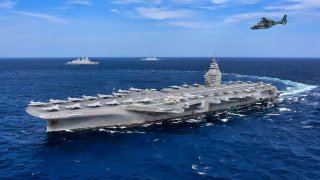France’s New PANG Aircraft Carrier is Shaping Up Fast: Armed With Lasers
France is progressing with its next-generation aircraft carrier, the PANG (porte-avions de nouvelle génération), set to begin construction in 2031 and enter service by the late 2030s. Recent developments include awarding contracts for long lead items like nuclear propulsion systems to Naval Group, Chantiers de l’Atlantique, and TechnicAtome.
Summary: France is progressing with its next-generation aircraft carrier, the PANG (porte-avions de nouvelle génération), set to begin construction in 2031 and enter service by the late 2030s. Recent developments include awarding contracts for long lead items like nuclear propulsion systems to Naval Group, Chantiers de l’Atlantique, and TechnicAtome.
-The new aircraft carrier, expected to rival the size of the Charles de Gaulle, will feature advanced nuclear reactors designed to deliver up to 230 megawatts, supporting high speeds and sophisticated systems such as EMALS (Electromagnetic Aircraft Launch System) and directed energy weapons.
-This project aims to extend France's naval capabilities significantly, emphasizing massive power projection, situational autonomy, and seamless integration with France’s strategic forces. The PANG will also continue using the CATOBAR system for aircraft recovery, marking a significant evolution in French naval engineering and strategic maritime capabilities.
France Advances on Future Aircraft Carrier PANG with Nuclear Innovation
It will still be more than a decade before the French Navy’s next-generation aircraft carrier is set to enter service. In fact, construction has yet to begin on the PANG (porte-avions de nouvelle génération)—but that doesn’t mean that progress isn’t being made.
The French Ministry of the Armed Forces has awarded the first contract for the order of long lead items for the future flattop. Naval Group, Chantiers de l’Atlantique, and Technicatome have received notifications to begin long-term services, including the development of nuclear propulsion systems.
Shipbuilder Naval Group will be tasked with the industrialization and production of the main components of nuclear reactors, while the Chantiers de l’Atlantique shipyard is now adapting its industrial facilities for the construction phase in Saint-Nazaire. TechnicAtome is the prime contractor for the nuclear reactors and is in charge of their design.
The production and construction phase will start in early 2031 in Saint-Nazaire.
It had been previously speculated that the PANG would likely be nuclear-powered with two K22 reactors, while it is believed the future carrier would be a similar size to French Marine Nationale’s flagship, Charles de Gaulle. The PANG is also expected to be capable of embarking an airwing that would include thirty-two next-generation fighter jets.
According to a 2021 French Navy budget report that highlighted key points for the program, the future carrier would provide long-term control of air and sea spaces, massive and repeatable power projection far from its homeport, an autonomous assessment of the situation (SITREP), and notably, it would be complementary with the strategic oceanic force (FOST) and the strategic air forces (FAS).
As of 2024, the project has reached the detailed pre-project phase, with a launch and implementation dossier expected to be completed by the end of 2025.
Nuclear-powered and EMALS-equipped
The new model of the K-22 nuclear reactors is now being developed by Framatome Défense in collaboration with TechnicAtome, and is designed to deliver 220 to 230 megawatts of energy, enabling the carrier to reach speeds of 30 knots and operate advanced systems like electromagnetic catapults (EMALS) and directed energy weapons (DEWs).
The French Marine Nationale has been developing DEWs for several years and has seen the weapons technology as critical as it expands its military presence in the Indo-Pacific region.
The new carrier is also expected to implement the CATOBAR system (Catapult Assisted Take-Off But Arrested Recovery), which has been a standard in French carriers since the 1960s—unlike the Russian, British, and Chinese carriers that employ ski-jump ramps.
As Naval Recognition noted, the integration of electromagnetic catapults, which are significantly lighter than traditional steam catapults, will enhance operational flexibility and enable the launch of a wide range of aircraft, from drones to the new generation fighter jets.

Though the future flagship won’t enter service until at least the late 2030s, it will be a major step forward in carrier development.
Author Experience and Expertise: Peter Suciu
Peter Suciu is a Michigan-based writer. He has contributed to more than four dozen magazines, newspapers, and websites with over 3,200 published pieces over a twenty-year career in journalism. He regularly writes about military hardware, firearms history, cybersecurity, politics, and international affairs. Peter is also a Contributing Writer for Forbes and Clearance Jobs. You can follow him on Twitter: @PeterSuciu. You can email the author: [email protected].
Image Credit: Creative Commons.


